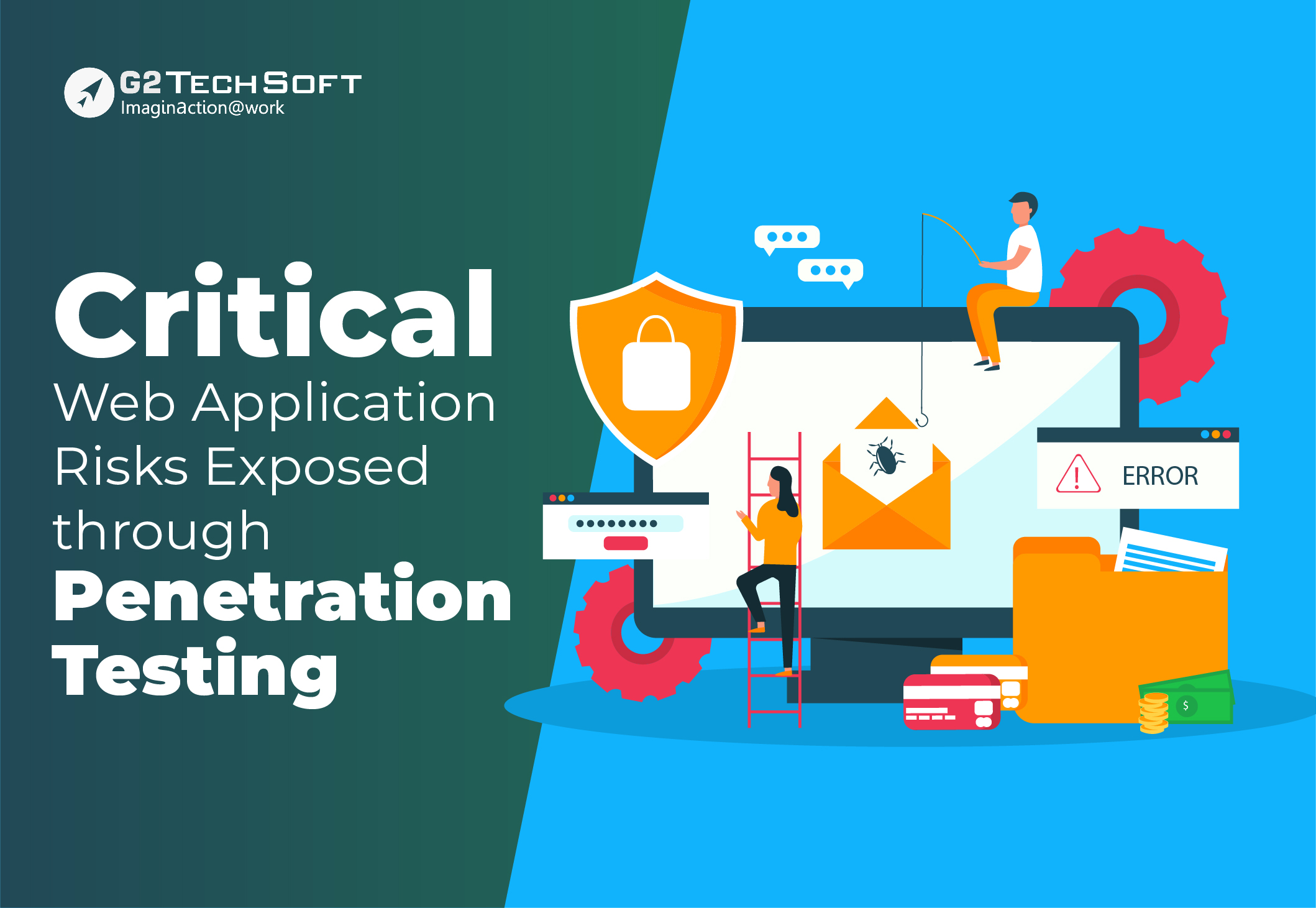
Critical Web Application Risks Exposed Through Penetration Testing
In the dynamic realm of today’s digital interactions, web applications stand as pivotal conduits for business operations and user engagements. However, their pervasive use also exposes them to an array of cyber threats that can compromise sensitive information and erode user trust. To fortify defenses against these evolving risks, proactive measures are essential, and at the forefront of these strategies is web application penetration testing, often known as ethical hacking.
As firms increasingly conduct activities online, the security and integrity of web applications become fundamental pillars in safeguarding sensitive data, managing reputations, ensuring regulatory compliance, preventing financial losses, enhancing user experiences, and ultimately mitigating risks.
This blog sets the stage for a comprehensive exploration into the world of web application penetration testing. This guide aims to unravel the significance of web application security, shed light on the risks associated with web applications, and showcase how penetration testing serves as a proactive defense mechanism. Join us on this journey to delve into the tools, techniques, and best practices that define the intricate landscape of web application penetration testing.
A Deep Dive Into Common Web Application Security Risks:
SQL Injections:
SQL injections pose a significant threat, permitting attackers to execute malicious SQL queries through input fields, potentially leading to data breaches or manipulation. Proper input validation and the implementation of parameterized queries emerge as critical measures to prevent SQL injection vulnerabilities.
Cross-Site Scripting (XSS):
Cross-site scripting (XSS) attacks enable hackers to inject scripts into web pages, compromising user data and facilitating redirection to malicious sites. Mitigating XSS involves rigorous input validation and output encoding, fortifying web applications against unauthorized script injections.
Cross-Site Request Forgery (CSRF):
Cross-site request forgery (CSRF) exploits cookies from other websites to initiate actions on behalf of users without their knowledge. The implementation of anti-CSRF tokens becomes crucial in ensuring that only legitimate users can initiate actions, preventing unauthorized manipulations.
Broken Access Controls:
Broken access controls expose web applications to unauthorized access, permitting users to gain entry to restricted resources. This vulnerability arises when proper access controls, including user roles and tiered privileges, are not effectively enforced. Robust access control mechanisms are essential for preventing unauthorized resource access.
Broken Authentication:
Broken authentication enables attackers to bypass authentication mechanisms, gaining unauthorized access to web app accounts. Weak password policies, insecure session management, and predictable authentication tokens contribute to this vulnerability. Strengthening authentication mechanisms is paramount for preventing unauthorized account access.
Security Misconfigurations:
Security misconfigurations occur when applications or their infrastructure are not securely set up. Examples include outdated protocols and default access permissions. Regular security audits and meticulous configuration management are imperative to prevent these vulnerabilities and maintain a secure web application environment.
Sensitive Data Exposure:
Sensitive data exposure arises when applications fail to adequately protect critical information like passwords or credit card details. Strong data encryption in transit and at rest, coupled with secure data storage practices, serves as a robust defense against potential data breaches. Ensuring encrypted data remains indecipherable even if intercepted by hackers is vital to managing this risk effectively.
Safeguarding Web Applications in a Few Key Steps:
Understanding Penetration Testing: Pivotal In Cybersecurity Defense
Penetration testing, prominently known as pen testing or ethical hacking, stands as a pivotal practice in defending web applications against ever-evolving cyber threats. This section provides insights into the essential role played by penetration testing in fortifying the security of web applications.
Detecting The Vulnerabilities:
At the core of penetration testing lies the task of detecting vulnerabilities within a web application. Ranging from misconfigurations to weak passwords and faulty coding, these vulnerabilities represent potential security risks that businesses can proactively mitigate by pinpointing and addressing them.
Mimicking Real-World Attacks:
Penetration tests go beyond theoretical assessments by replicating the techniques employed by malicious hackers. This simulation provides a realistic assessment of the application’s security posture, allowing organizations to address vulnerabilities before real attackers can exploit them.
Assessing The Impact:
Penetration testers not only identify vulnerabilities but also assess the potential impact of these weaknesses when exploited. This critical information helps businesses understand the gravity of security flaws, enabling them to prioritize remediation efforts effectively.
Enhancing Security Posture:
Regular penetration testing contributes to enhancing an organization’s overall security posture. By detecting areas with insufficient security measures, firms can implement the necessary changes, making it challenging for cybercriminals to compromise their web applications.
Meeting Compliance Requirements:
In many industries, adherence to strict regulatory compliance standards is mandatory. Penetration testing often emerges as a requirement to ensure compliance, making it an essential practice for businesses operating within regulated sectors.
Continuous Improvement:
The role of web application penetration testing extends beyond identification to fostering a culture of continuous improvement. Organizations, armed with insights from penetration testing, can take the necessary steps to fix vulnerabilities, preventing similar issues in the future.
Protecting User Data:
In the digital age, the protection of user information is a pivotal component. Penetration testing emerges as a crucial tool in safeguarding sensitive user data from breaches, contributing significantly to ensuring data privacy and reinforcing user trust.
Navigating The Core Strategies of Effective Penetration Testing:
Black Box Penetration Testing:
In this approach, pen testers simulate external attackers by exploiting vulnerabilities in the web application without prior knowledge. Both automated and manual techniques, along with social engineering, are employed to assess the application’s defenses against external threats.
White Box Penetration Testing:
Contrary to black box testing, white box testing provides pen testers with complete access to the application’s source code, databases, and infrastructure. This internal perspective allows for a thorough examination of security controls, identification of vulnerabilities, and assessment of potential risks, especially those related to code quality, logic flaws, and configuration issues.
Gray Box Penetration Testing:
Combining elements of both black box and white box testing, gray box testing strikes a balance. Pentesters possess partial knowledge of the application’s inner workings, enabling them to focus on specific areas of concern while exploring real-world attack vectors. This approach provides a comprehensive view of vulnerabilities and their potential impact from different perspectives.
A Comprehensive Guide To The Penetration Testing Process:
Penetration testing is a systematic approach to identifying and mitigating the risks associated with web applications. The process involves several pivotal steps to ensure a thorough examination of security vulnerabilities.
Planning And Information Gathering:
The initial phase focuses on meticulous planning, goal definition, and scoping. Testers gather essential information about the target, including network architecture and application details, to lay the groundwork for the testing process.
Scanning And Enumeration:
Employing specialized web application penetration testing tools, testers scan the target environment to identify open ports, services, and potential vulnerabilities. Enumeration involves extracting detailed information about the target to enhance the understanding of the attack surface.
Vulnerability Analysis:
Testers meticulously analyze the gathered information to identify potential vulnerabilities and weaknesses in the web application or network. This phase is crucial for comprehending the scope and severity of potential security threats.
Exploitation:
In this phase, testers simulate real-world attacks to exploit identified vulnerabilities. The goal is to assess the severity and potential impact of security flaws, providing insights into the effectiveness of the application’s defenses.
Post-Exploitation:
Following a successful attack simulation, testers assess the compromised system to demonstrate the extent of a potential breach. This step will be pivotal for understanding the consequences of a security compromise.
Reporting And Remediation:
Testers compile a comprehensive report detailing their findings, emphasizing vulnerabilities and potential risks discovered during the penetration testing process. The report includes recommendations for remediation and improvements to enhance web application security.
Key Takeaways:
Penetration testing is a proactive strategy crucial for detecting and mitigating the risks associated with data breaches and reputational damage. Through this meticulous process, organizations gain insights into critical web application risks, enabling effective vulnerability mitigation.
In the dynamic cybersecurity landscape, regular penetration testing is essential to stay ahead of evolving threats. This approach involves not only fixing vulnerabilities but also proactively preventing exploitation, ensuring a resilient defense.
Embracing web application penetration testing is imperative for ongoing digital asset protection and building user trust in the reliability of provided services.
G2 Techsoft: Your Trusted Partner For Right Penetration Testing Service
Utilize penetration testing as a powerful means to detect concealed vulnerabilities in web application security, safeguard sensitive data from breaches, and maintain user trust. For assessing your app’s defenses, reach out to the expert team at G2 Techsoft.




